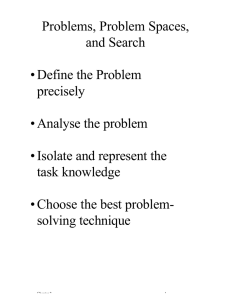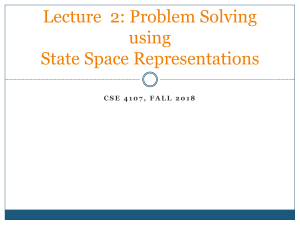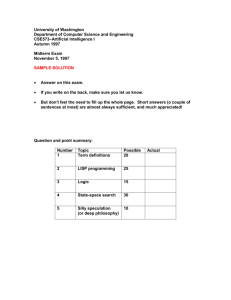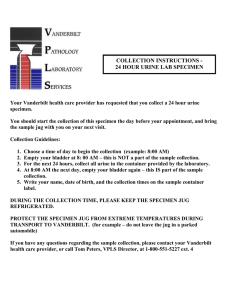Lecture 2 State Space Search
advertisement
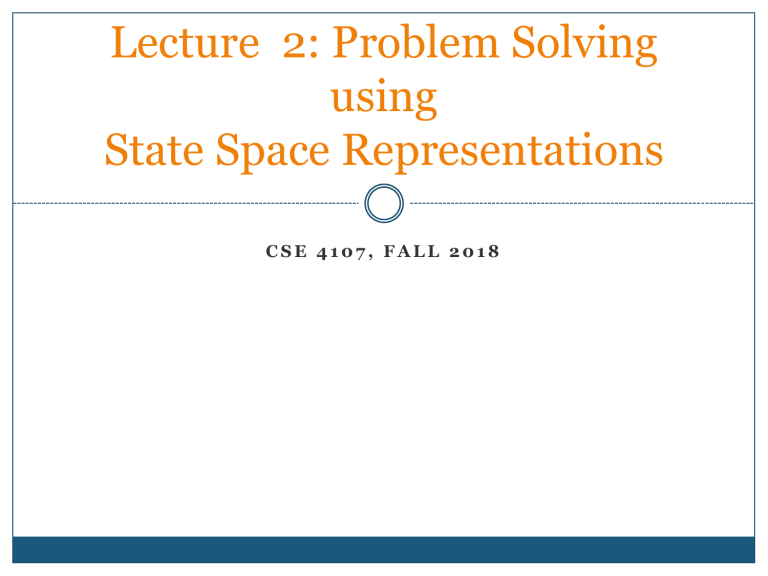
Lecture 2: Problem Solving
using
State Space Representations
CSE 4107, FALL 2018
Overview
Characteristics of agents and environments
Problem-solving agents where search consists of
state space
operators
start state
goal states
Abstraction and problem formulation
Search trees: an effective way to represent the search process
Reading: chapter 2 and chapter 3.1, 3.2, 3.3
Agents
An agent is anything that can be viewed as perceiving
its environment through sensors and acting upon that
environment through actuators
Human agent:
eyes, ears, and other organs for sensors;
hands, legs, mouth, and other body parts for
actuators
Robotic agent:
cameras and infrared range finders for sensors;
various motors for actuators
Agents and environments
The agent function maps from percept histories to actions:
[f: P* A]
The agent program runs on the physical architecture to produce f
agent = architecture + program
Vacuum-cleaner world
Percepts: location and state of the environment, e.g.,
[A,Dirty], [A,Clean], [B,Dirty]
Actions: Left, Right, Suck, NoOp
Task Environment
Before we design an intelligent agent, we must
specify its “task environment”:
PEAS:
Performance measure
Environment
Actuators
Sensors
Performance measure
Performance measure: An objective criterion for success of
an agent's behavior, e.g.,
Robot
driver?
Chess-playing program?
Spam email classifier?
Rational Agent
8
Rational Agent: selects actions that is expected to
maximize its performance measure,
given
percept sequence
given agent’s built-in knowledge
sidepoint:
how to maximize expected future performance,
given only historical data
Md. Wasi Ul Kabir
2/17/2019
PEAS
Example: Agent = robot driver in DARPA Challenge
Performance measure:
Time to complete course
Environment:
Roads, other traffic, obstacles
Actuators:
Steering wheel, accelerator, brake, signal, horn
Sensors:
Optical cameras, lasers, sonar, accelerometer, speedometer, GPS,
odometer, engine sensors,
PEAS
Example: Agent = Medical diagnosis system
Performance measure:
Healthy patient, minimize costs, lawsuits
Environment:
Patient, hospital, staff
Actuators:
Screen display (questions, tests, diagnoses, treatments,
referrals)
Sensors:
Keyboard (entry of symptoms, findings, patient's answers)
Environment types
Fully observable (vs. partially observable):
An agent's sensors give it access to the complete state of the
environment at each point in time.
Deterministic (vs. stochastic):
The next state of the environment is completely determined
by the current state and the action executed by the agent.
If the environment is deterministic except for the actions of
other agents, then the environment is strategic
Deterministic environments can appear stochastic to an
agent (e.g., when only partially observable)
Episodic (vs. sequential):
An agent’s action is divided into atomic episodes. Decisions
do not depend on previous decisions/actions.
Environment types
Static (vs. dynamic):
The environment is unchanged while an agent is deliberating.
Discrete (vs. continuous):
A discrete set of distinct, clearly defined percepts and actions.
How we represent or abstract or model the world
Single agent (vs. multi-agent):
An agent operating by itself in an environment. Does the other
agent interfere with my performance measure?
task
environm.
observable
deterministic/
stochastic
episodic/
sequential
static/
dynamic
discrete/
continuous
agents
crossword
puzzle
fully
determ.
sequential
static
discrete
single
chess with
clock
fully
strategic
sequential
semi
discrete
multi
partial
stochastic
sequential
dynamic
continuous
multi
fully
determ.
episodic
semi
continuous
single
partpicking
robot
partial
stochastic
episodic
dynamic
continuous
single
refinery
controller
partial
stochastic
sequential
dynamic
continuous
single
interact.
tutor
partial
stochastic
sequential
dynamic
discrete
multi
poker
taxi
driving
medical
diagnosis
image
analysis
What is the environment for the DARPA Challenge?
Agent = robotic vehicle
Environment = 130-mile route through desert
Observable?
Deterministic?
Episodic?
Static?
Discrete?
Agents?
Agent types
Five basic types in order of increasing generality:
Simple reflex agents
Model-based reflex agents
Goal-based agents
Problem-solving agents
Utility-based agents
Can distinguish between different goals
Learning agents
Simple reflex agent architecture
17
Md. Wasi Ul Kabir
2/17/2019
Architecture for model-based agent
18
Md. Wasi Ul Kabir
2/17/2019
Architecture for goal-based agent
Architecture for a complete
utility-based agent
Problem-Solving Agents
Intelligent agents can solve problems by searching a state-space
State-space Model
the agent’s model of the world
usually a set of discrete states
e.g., in driving, the states in the model could be towns/cities
Goal State(s)
a goal is defined as a desirable state for an agent
there may be many states which satisfy the goal test
e.g., drive to a town with a ski-resort
or just one state which satisfies the goal
e.g., drive to Mammoth
Operators (actions, successor function)
operators are legal actions which the agent can take to move
from one state to another
Example: Traveling in Romania
Example: Traveling in Romania
On holiday in Romania; currently in Arad
Flight leaves tomorrow from Bucharest
Formulate goal:
be in Bucharest
Formulate problem:
states: various cities
actions/operators: drive between cities
Find solution
By searching through states to find a goal
sequence of cities, e.g., Arad, Sibiu, Fagaras, Bucharest
Execute states that lead to a solution
State-Space Problem Formulation
A problem is defined by four items:
1. initial state e.g., "at Arad“
2. actions or successor function
S(x) = set of action and state pairs
e.g., S(Arad) = {<Arad Zerind, Zerind>, … }
3. goal test (or set of goal states)
e.g., x = "at Bucharest”, Checkmate(x)
4. path cost (additive)
e.g., sum of distances, number of actions executed, etc.
c(x,a,y) is the step cost, assumed to be ≥ 0
A solution is a sequence of actions leading from the initial state
to a goal state
Abstraction
Definition of Abstraction:
Process of removing irrelevant detail to create an
abstract representation: ``high-level”, ignores
irrelevant details
Abstraction
Navigation Example: how do we define states and
operators?
First step is to abstract “the big picture”
i.e., solve a map problem
nodes = cities, links = freeways/roads (a high-level description)
this description is an abstraction of the real problem
Can later worry about details like freeway onramps, refueling,
etc
Abstraction is critical for automated problem solving
must create an approximate, simplified, model of the world for
the computer to deal with: real-world is too detailed to model
exactly
good abstractions retain all important details
The State-Space Graph
Graphs:
nodes, arcs, directed arcs, paths
Search graphs:
States are nodes
operators are directed arcs
solution is a path from start S to goal G
Problem formulation:
Give an abstract description of states, operators, initial state and goal
state.
Problem solving:
Generate a part of the search space that contains a solution
Example: 8-queens problem
State-Space problem formulation
states? -any arrangement of n<=8 queens
-or arrangements of n<=8 queens in leftmost n
columns, 1 per column, such that no queen
attacks any other.
initial state? no queens on the board
actions? -add queen to any empty square
-or add queen to leftmost empty square such
that it is not attacked by other queens.
goal test? 8 queens on the board, none attacked.
path cost? 1 per move
Example: Robot Assembly
States
Initial state
Actions
Goal test
Path Cost
Example: Robot Assembly
States: configuration of robot (angles, positions)
and object parts
Initial state: any configuration of robot and object
parts
Actions: continuous motion of robot joints
Goal test: object assembled?
Path Cost: time-taken or number of actions
Learning a spam email classifier
States
Initial state
Actions
Goal test
Path Cost
Learning a spam email classifier
States: settings of the parameters in our model
Initial state: random parameter settings
Actions: moving in parameter space
Goal test: optimal accuracy on the training data
Path Cost: time taken to find optimal parameters
Example: 8-puzzle
states?
initial state?
actions?
goal test?
path cost?
Example: 8-puzzle
states? locations of tiles
initial state? given
actions? move blank left, right, up, down
goal test? goal state (given)
path cost? 1 per move
A Water Jug Problem
You have a 4-
gallon and a 3gallon water jug
You have a faucet
with an unlimited
amount of water
You need to get
exactly 2 gallons
in 4-gallon jug
Puzzle-solving as Search
State representation: (x, y)
x: Contents of four gallon
y: Contents of three gallon
Start state: (0, 0)
Goal state (2, n)
Operators
Fill 3-gallon from faucet, fill 4-gallon from faucet
Fill 3-gallon from 4-gallon , fill 4-gallon from 3-gallon
Empty 3-gallon into 4-gallon, empty 4-gallon into 3-gallon
Dump 3-gallon down drain, dump 4-gallon down drain
Production Rules for the Water Jug Problem
1 (x,y) (4,y)
if x < 4
Fill the 4-gallon jug
2 (x,y) (x,3)
if y < 3
Fill the 3-gallon jug
3 (x,y) (x – d,y)
if x > 0
Pour some water out of the 4-gallon
jug
4 (x,y) (x,y – d)
if x > 0
Pour some water out of the 3-gallon
jug
5 (x,y) (0,y)
if x > 0
Empty the 4-gallon jug on the ground
The Water Jug Problem (cont’d)
6 (x,y) (x,0)
if y > 0
Empty the 3-gallon jug on the ground
7 (x,y) (4,y – (4 – x))
if x + y ≥ 4 and y > 0
Pour water from the 3-gallon jug into the 4gallon jug until the 4-gallon jug is full
8 (x,y) (x – (3 – y),3)
if x + y ≥ 3 and x > 0
Pour water from the 4-gallon jug into the 3gallon jug until the 3-gallon jug is full
9 (x,y) (x + y, 0)
if x + y ≤ 4 and y > 0
Pour all the water from the 3-gallon jug
into the 4-gallon jug
10 (x,y) (0, x + y)
if x + y ≤ 3 and x > 0
Pour all the water from the 4-gallon jug
into the 3-gallon jug
One Solution to the Water Jug Problem
Gallons in the 4Gallon Jug
Gallons in the 3Gallon Jug
Rule Applied
0
0
2
0
3
9
3
0
2
3
3
7
4
2
5
0
2
9
2
0
Tree-based Search
Basic idea:
Exploration of state space by generating successors of alreadyexplored states (a.k.a. expanding states).
Every state is evaluated: is it a goal state?
In practice, the solution space can be a graph, not a
tree
E.g., 8-puzzle
More general approach is graph search
Tree search can end up repeatedly visiting the same nodes
Unless it keeps track of all nodes visited
…but this could take vast amounts of memory
Tree search example
Tree search example
Tree search example
Tree search example
This “strategy”
what differentia
different searc
algorithms
States versus Nodes
A state is a (representation of) a physical configuration
A node is a data structure constituting part of a search tree contains
info such as: state, parent node, action, path cost g(x), depth
The Expand function creates new nodes, filling in the various fields
and using the SuccessorFn of the problem to create the
corresponding states.
State Spaces versus Search Trees
State Space
Set of valid states for a problem
Linked by operators
e.g., 20 valid states (cities) in the Romanian travel problem
Search Tree
Root node = initial state
Child nodes = states that can be visited from parent
Note that the depth of the tree can be infinite
Partial search tree
E.g., via repeated states
Portion of tree that has been expanded so far
Fringe
Leaves of partial search tree, candidates for expansion
Search trees = data structure to search state-space
Search Tree for the 8 puzzle problem
Search Strategies
A search strategy is defined by picking the order of
node expansion
Strategies are evaluated along the following
dimensions:
completeness: does it always find a solution if one exists?
time complexity: number of nodes generated
space complexity: maximum number of nodes in memory
optimality: does it always find a least-cost solution?
Time and space complexity are measured in terms of
b: maximum branching factor of the search tree
d: depth of the least-cost solution
m: maximum depth of the state space (may be ∞)
Why Search can be hard
Assuming b=10, 1000 nodes/sec, 100 bytes/node
Depth of
Solution
Nodes to
Expand
Time
Memory
0
1
1 millisecond
100 bytes
2
111
0.1 seconds
11 kbytes
4
11,111
11 seconds
1 megabyte
8
108
31 hours
11 giabytes
12
1012
35 years
111 terabytes
Uninformed search
Breadth-first, depth-first
Uniform cost
Iterative deepening
Informed (heuristic) search
Greedy best-first
A*
Memory-bounded heuristic search
And more….
Local search and optimization
Hill-climbing
Simulated annealing
Genetic algorithms
Summary
Characteristics of agents and environments
Problem-solving agents where search consists of
state space
operators
start state
goal states
Abstraction and problem formulation
Search trees: an effective way to represent the search process
Reading: chapter 2 and chapter 3.1, 3.2, 3.3
References
53
1.https://en.wikipedia.org/wiki/Artificial_intelligen
ce
2. http://aima.cs.berkeley.edu/
Md. Wasi Ul Kabir
2/17/2019
54
Questions ?
Md. Wasi Ul Kabir
2/17/2019
